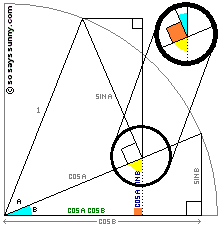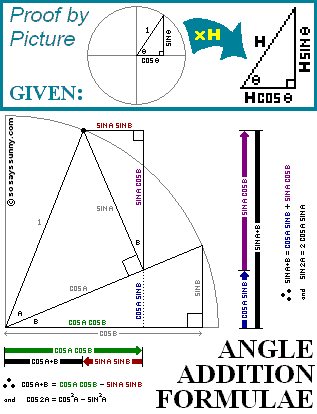A “Proof by Picture” of the Angle Addition Formulas
All you need to know in order to follow the proof is:
- The basic trig identities:
- The center angle of the triangle is Θ.
- The hypotenuse is 1 (a radius of the unit circle).
- The side adjacent is cos Θ.
- The side opposite is sin Θ.
- The angle between the adjacent and opposite sides is a right angle.
- That any triangle can be scaled by a factor H:
- The angles stay the same.
- The sides are all multiplied by H.
- The hypotenuse in this example would become 1 × H = H.
PROOF WALK-THROUGH:
Start with base triangle B, the one with the center angle B. Using the fundamental trig identities, label the sides cos B and sin B.
Now draw the center angle A, measuring from the top of angle B and extending the ray to become a radius of the unit circle.
Our goal is to discover the coordinates of the black dot (●) where this radius intersects the unit circle. The x-coordinate will be the solution to cos (A+B) and the y-coordinate will be the solution to sin (A+B).
In order to use basic trig properties, triangle A needs to be a right triangle, with the radius as the hypotenuse and the right angle opposite. Draw the right angle by dropping a perpendicular from the black dot (●) to the hypotenuse of triangle B.
Triangle A is now a right triangle with a hypotenuse of 1. Use the basic trig identities to label the sides cos A and sin A.
Notice that we can’t just add sin A and sin B to get our y-coordinate: sin A doesn’t begin at the top of sin B and isn’t vertical. So we have to try something else.
The base of triangle A is resting on the hypotenuse of triangle B. Drop a perpendicular from the right angle of triangle A and make it a dotted line.
This dotted line intersects the base of triangle B at a right angle, creating a smaller right triangle with a hypotenuse of cos A. Using basic trig identities and the scaling of triangles, label the sides of this smaller triangle cos A cos B on the adjacent side and cos A sin B on the opposite side (dotted line).
So now we know how high sin A starts — that solves the first issue. But what about the fact that sin A isn’t vertical?
To solve this second issue, extend the dotted line upward. We’re looking for the y-coordinate of the black dot (●), so draw a horizontal line to the right to intersect with the new vertical line.
Since horizontal and vertical lines are perpendicular, we can mark that intersection as a right angle. This creates a new right triangle, tipped sideways on its point, with a hypotenuse of sin A.
What else can we know about this new triangle?
 ASIDE: Back when I was first learning the properties of triangles, our teacher handed out a bunch of brightly colored construction paper triangles. They were all different: large, medium, small; right, acute, obtuse; equilateral, isosceles, scalene. She had us tear off the corners of our triangle and line them up next to each other. No matter what the triangle looked like at the beginning, its corners always fit together to make a straight line. This was how we learned that all triangles have internal angles that add up to 180 degrees (a straight line).
ASIDE: Back when I was first learning the properties of triangles, our teacher handed out a bunch of brightly colored construction paper triangles. They were all different: large, medium, small; right, acute, obtuse; equilateral, isosceles, scalene. She had us tear off the corners of our triangle and line them up next to each other. No matter what the triangle looked like at the beginning, its corners always fit together to make a straight line. This was how we learned that all triangles have internal angles that add up to 180 degrees (a straight line).
So, looking at the left side of the vertical line, imagine the torn-off corners of a triangle. We see the top angle of the small base triangle (YELLOW) and a right angle — which could be a stand-in for the right angle (ORANGE) of the small base triangle — so the last angle, the one in the on-its-point triangle, must be the same as the third angle in the small base triangle (AQUA): it must be the same as angle B.
Now we see that the on-its-point triangle is a right triangle with an angle B and a hypotenuse of sin A. What we’d like to know is the length of the vertical side. Using basic trig identities and the scaling of triangles, label the sides of the on-its-point triangle sin A cos B on the adjacent side (vertical) and sin A sin B on the opposite side (horizontal).
Now everything is labeled, so we just need to combine the parts to get our coordinates.
To get the x-coordinate, go right cos A cos B and left sin A sin B, so:
x-coordinate = cos (A+B) = cos A cos B – sin A sin B
To get the y-coordinate, go up cos A sin B and up sin A cos B, so:
y-coordinate = sin (A+B) = cos A sin B + sin A cos B
The Double-Angle Formulas
(when angle A = angle B)
We can use these same formulas, just make all the angles A:
cos (A+B) = cos A cos B – sin A sin B
cos (A+A) = cos A cos A – sin A sin A
cos (2A) = cos² A – sin² A
sin (A+B) = cos A sin B + sin A cos B
sin (A+A) = cos A sin A + sin A cos A
sin (2A) = 2 cos A sin A
Conclusion
This entire proof is built into the picture. Once you’ve worked it out for yourself and drawn the diagram a few times, you can simply remember the picture to remember the formulas. And now you know that you can always derive them again if you need to.
ON A PERSONAL NOTE:
I’m a very visual person and was struggling to memorize these formulae in college calculus (1993/1994).
I knew there must be a logical reason why one formula had a plus and one had a minus (and why it was the sine term that had the minus sign). I mentioned my struggle to my calculus professor, Dr. Myrtle Lewin, but she said she didn’t know of a visual proof for these formulae. [This was before the Internet really got going.]
So I took paper and tried to draw a picture to explain it. Unfortunately, my first scribbles were so crude that I didn’t notice I’d lost the 90-degree angle on the stacked triangle — I was accidentally making its opposite side have both ends on the circle.
I put it aside to go hang out with some friends in my dorm. In the middle of a conversation, in the middle of a sentence, I sort of zoned out and made angles with my fingers and said: “Gotta go … just figured something out for Calculus!”
After correcting my drawing, checking it over and over, and feeling pretty darn proud of my accomplishment, I called Dr. Lewin at home. Although it was after 9 PM, she was excited to hear about my breakthrough and wanted me to talk her through the visual proof over the phone.
Some of the most cherished praise I’ve ever received was when Dr. Lewin said (in her South African British / Dutch accent):
“Oh, Sunny! How elegant! What a beautiful ‘Proof by Picture!'”
I hope this diagram helps you, too — not only to memorize the formulae, but also to know that you can discover math for yourself and find novel ways to explain it.
Math isn’t just some dead thing to memorize, handed down from older folks — It’s a way of seeing the world and working through obstacles. It’s not just something you do; it becomes something you are.



Leave a comment